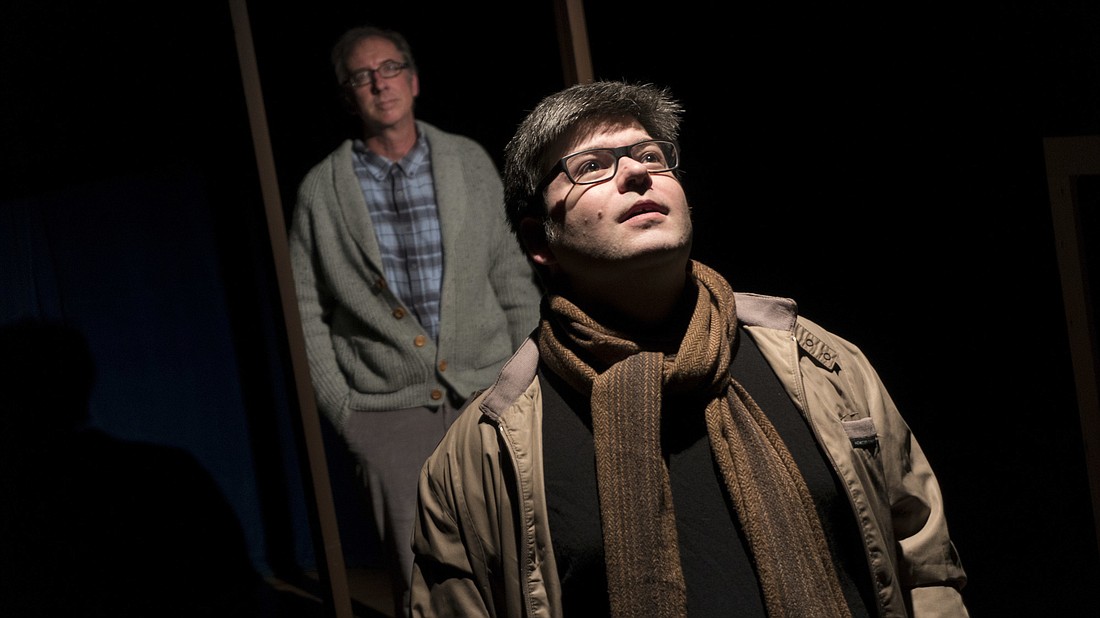- July 13, 2025
-
-
Loading

Loading

Donald Margulies’ “Sight Unseen” offers a portrait of a self-doubting artist in a nuanced Two Chairs production at the Players Centre for Performing Arts.
You say you’re an artist. Are you for real, or are you a fraud?
That is the question.
And every real artist wrestles with it.
For starving artists, it can lead to nervous breakdowns and broken marriages. But rich, successful artists suffer, too. Jonathan Waxman (Dylan Jones), the hero of Donald Margulies’ “Sight Unseen” is one of them.
Critics love him. Collectors buy his work — before he’s even finished it. They sign big checks and buy his paintings in advance, sight unseen. Waxman’s made the big time. But he’s still not happy.
Waxman was born in Brooklyn, and raised in a strict Jewish family. He carved out his own identity as a painter. He had a brief fling with his shiksa model, Patricia (Lauren Ward), and then rejects her. A decade later, he’s happily married and living large in the USA. Patricia’s living in semipoverty in England, and lovelessly married to an older, painfully shy archeologist (Paul Hutchinson) in a deteriorating house in the country. Waxman flies into London for a retrospective exhibit of his work. The artist’s wife is conveniently pregnant, so he’s all on his own. After enduring a hostile interview with anti-Semitic overtones, he hits the M-5 motorway. He pays Patricia a surprise visit, talks about old times, and quickly opens old wounds.
Why did he reject her? That is now the question. Waxman doesn’t give a real answer. Waxman’s in awe of the nude portrait he did of Patricia back in college. It’s so real. So honest. That’s when he found his art — and possibly true love. Why did he walk away? Is the rest of his life a lie? That question also burns in Waxman’s mind.
He awkwardly accepts an equally awkward invitation to stay the night. The archeologist confronts him before he hits the sack — and basically says he is a fraud. Visual art reached its pinnacle in the Renaissance. Painters should have quit while they were ahead. You should definitely quit now. Waxman grinds his teeth and lets it go. In the morning, Waxman makes a Faustian pitch to add Patricia’s portrait to the retrospective.
That summary is in chronological order, but the play jumps around in time. You’re probably thinking Quentin Tarantino or Harold Pinter, but Margulies has a different bag of temporal tricks. He’s not so interested in joining the broken links of the chain of causality. He wants to leave the questions hanging.
Margulies’ play puts the artist on trial. It’s really a series of accusations — a litany of Waxman’s self-doubts. The play doesn’t reach a verdict. You’re the jury. You decide.
Director Elliott Raines never goes for effect, always gets to the heart of the matter, never phones it in, and always punches above his weight. The rhythms of dialogue and reaction have a natural feel in his hands. The comic timing never feels like timing. The characters think, and you can tell.
Props (no pun intended) also to Ken Junkins’ set, Georgina Wilmott’s costumes, and Matt Neier’s lighting. They do more with less in the intimate Backstage space.
The actors keep it real and convey a passionate sense of the human heart in conflict. Jones’ Waxman conveys the ideal combination of arrogance and insecurity. His character hates himself, loves himself, believes in himself and doesn’t. Ward is brilliant as Patricia in different time frames; she morphs from young love to 30-something burnout in the blink of an eye. Hutchinson delivers a wicked comic performance as the archeologist. He’s a man of few words, but those words are well-aimed darts. Kudos also to Cindy Schlotterback for her brief scenes as a German journalist, subjecting Waxman to a hit-and-run interview. She’s a smiling character assassin, who reduces the artist’s life to his Jewish identity. Or tries.
Is Waxman a fraud or not?
Various characters accuse him of painting for shock value. You hear these paintings described. A black man making love (or raping) a white woman in a desecrated Jewish ceremony, and so on. Hearing these descriptions, you automatically leap to conclusions. I did. Until it occurred to me that Margulies made a verdict impossible.
You never actually see Waxman’s paintings. There’s no way to judge.
But of course, we do anyway.